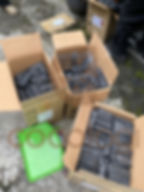Factors Affecting Lump Charcoal Weight
- Fauzanil Azmy
- Jul 6, 2023
- 2 min read
Lump charcoal is a popular fuel for grilling, smoking, and other outdoor activities. It is made by heating wood in a low-oxygen environment, inside klin, which causes the wood to carbonize and lose most of its moisture. During the process, the weight of lump charcoal can vary depending on a number of factors, including the type of wood used, the moisture content inside the wood, the temperature and duration of the klin process, and the presence of impurities in the wood.

Type of Wood
Ofcourse, the type of hard wood that are being used to make lump charcoa,l has a significant impact on its end product weight. Hardwoods, such as oak and maple, produce denser and heavier charcoal than softwoods, such as pine. This is because hardwoods have a higher density and a lower moisture content than softwoods. Thus many lump charcoal is made 100% from hardwood.

Moisture Content
The moisture content of the hardwood also affects the weight of lump charcoal. The drier the wood, the more weight it will lose during the charcoal making process. This is because water is a major component of wood, and it evaporates during the pyrolysis/klin process.
Temperature and Duration of the Pyrolysis Process
The temperature and duration of the pyrolysis process also affect the weight of lump charcoal. The higher the temperature and the longer the duration, the more weight the wood will lose. This is because the higher temperatures and longer durations cause the wood to carbonize more completely, which can produce a very good quality of charcoal.

Presence of Impurities
The presence of impurities in the wood can also add weight to the charcoal. Impurities, such as ash and resin, can remain in the charcoal after the pyrolysis process. This is because they are not vaporized at the same temperatures as the wood. Thus the varies of pyrolysis temperature during the process, will affect the impurities inside the end product.
Manufacturing Process
The way in which the charcoal is made can also affect its weight. For example, charcoal that is made in a kiln will typically be denser and heavier than charcoal that is made in a pit. This is because kilns provide a more controlled environment for the pyrolysis process, which results in a more complete carbonization of the wood.

Conclusion
In general, lump charcoal that is made from hard woods, has a low moisture content, and is made in a kiln will be the heaviest. Lump charcoal that is made from soft woods, has a high moisture content, and is made in a pit will be the lightest. It is important to note that the weight of lump charcoal can also vary depending on the brand qualitu, and its product specification. When choosing lump charcoal, it is important to read the label carefully to get an accurate weight per unit. Or, do you want to talk with us about your charcoal quality? Let us know!
Keywords: Lump charcoal, hardwood charcoal, Indonesia lump charcoal, arang kayu,木炭、فحم